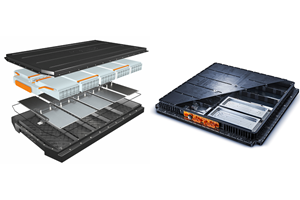Can we make recycled carbon fiber “sexy”?
Although we have methods to create useful product forms from recovered fiber, creating demand for those products will require new entrepreneurial effort.
I happened to catch a television commercial a couple days before writing this column that caused me both to laugh and to appreciate the advanced composites industry. The product was a spray-painting kit that enables the user to give a “woven carbon fiber look” to vehicle components, such as aluminum wheels and plastic mirror housings. First, one shade of black paint is applied and dried, then a template with square holes is placed over the top, and a slightly different shade of black paint is applied to yield the woven pattern. The result is sprayed with a clearcoat to give it depth and achieve the “look.”
At a 2003 Society of Plastic Engineers conference, I gave a presentation on what was then rapid commercialization of carbon fiber in sports cars, driven partly by performance and partly because it had “sex appeal” because of its high-tech nature. At that time, especially in California, the tuner market had gained momentum, and many cars sported hoods made of chopped fiberglass with a single ply of clearcoated carbon fiber fabric. Not much weight was saved, but it sure looked like it would go fast. This desire extended into consumer goods, as exemplified in a story I wrote for CW predecessor Composites Technology about carbon fiber skateboards, home telescopes, knife handles, camera tripods and guitars. The look was as important as any performance benefits. These early applications spawned a parallel industry around carbon-patterned decals, laminates and black-colored fabrics, all designed to mimic the characteristic weave at much lower cost.
As I walked the North American International Auto Show in Detroit this past January, there was still plenty of clearcoated carbon fiber on “eye candy” display. Most of it was truly carbon fiber. In many cases, it was purely cosmetic, in mirror housings, instrument panel and console inlays and engine covers. But a fair bit was structural, used in spoilers, splitters and roof panels as well as wheels. In these structural cases, the parts could have been made more cost-effectively, using lower-cost UD tapes or nonwoven multiaxial fabrics, and then painted in body color. But no doubt, the marketers at the OEMs insisted on the clearcoat look to make sure that the customers knew those parts were carbon fiber.
Then I stumbled upon something I didn’t expect to see: the latest edition of the BMW i8 electric hybrid with a roof panel of clearcoated recycled carbon fiber mat, fully exposed in a highly visible location. While I’m not sure if the recycled material was more than skin deep, the logic was not lost on me, especially from a marketing standpoint. Let’s see: electric vehicle = green; light-weight structure = green; recycling = green; a perfect combination! Seems to be a great angle from a marketing standpoint.
It’s no secret within the industry that BMW is generating a lot of carbon fiber offal from the current processes used to fabricate the structures of the i3 and i8 vehicles. We also know that they, and others, are working hard to find ways to incorporate that waste material back into functional vehicle parts.
As an industry, we generate much more scrap fiber, fabric and prepreg than we can find homes for. We have developed methods to create useful product forms from recovered fiber, but the demand is not there.
Obviously, we need to continue working on how to generate less scrap and offal in our manufacturing processes. This has clear cost, energy and environmental benefits. The aerospace industry has made great strides in this area with automated tape layup (ATL) and automated fiber placement (AFP) technologies, but these processes are very slow and expensive, today, for smaller, complex-shaped parts like those used in automobiles. There is much work going on, but we are probably a couple years away from using ATL/AFP technology at mass-production scale to meet automotive rate, reproducibility and cost targets.
So how can we make recycled carbon fiber “sexy” and drive demand across multiple markets? I’ve heard lots of resistance about “material pedigree” and not having material property data for design of structural parts using recycled carbon fibers. Can we use recovered fibers in injection molding compounds for electronics and other parts? Could clearcoated mats appeal to consumers in furniture, musical instruments and other products, if marketed properly? How about as a replacement for fabrics used in aircraft interior panels? I, for one, would find a clearcoated carbon mat attractive on an aircraft luggage-bin door. It seems there’s a great opportunity for recycled carbon fiber, ripe for some ambitious entrepreneurs to make an impact and solve a growing problem.
Institute for Advanced Composites Manufacturing Innovation (IACMI)
Related Content
The state of recycled carbon fiber
As the need for carbon fiber rises, can recycling fill the gap?
Read MoreMass, cost, durability improvements: EV battery enclosures, Part 2
As interest grows in composite battery covers and trays, composite materials suppliers work to meet current and future needs of automakers, battery module producers.
Read MoreOpportunities and challenges for composites in electric vehicles
Polymer and material specialists at chemical consulting firm ChemBizR reflect on the role of composites in current and future efforts to make electric vehicles more efficient — and more attractive for consumers.
Read MoreAptera reveals first composite production parts for BinC vehicle
Pre-production efforts are underway to begin building production-intent vehicles.
Read MoreRead Next
Composites end markets: Energy (2024)
Composites are used widely in oil/gas, wind and other renewable energy applications. Despite market challenges, growth potential and innovation for composites continue.
Read MoreCW’s 2024 Top Shops survey offers new approach to benchmarking
Respondents that complete the survey by April 30, 2024, have the chance to be recognized as an honoree.
Read MoreFrom the CW Archives: The tale of the thermoplastic cryotank
In 2006, guest columnist Bob Hartunian related the story of his efforts two decades prior, while at McDonnell Douglas, to develop a thermoplastic composite crytank for hydrogen storage. He learned a lot of lessons.
Read More


























